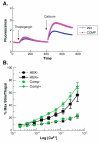Members of the thrombospondin gene family bind stromal interaction molecule 1 and regulate calcium channel activity
- PMID: 24845346
- PMCID: PMC4502920
- DOI: 10.1016/j.matbio.2014.05.004
Members of the thrombospondin gene family bind stromal interaction molecule 1 and regulate calcium channel activity
Abstract
The thrombospondins (TSPs) are a family of matricellular proteins that regulate cellular phenotype through interactions with a myriad of other proteins and proteoglycans. We have identified a novel interaction of the members of the TSP gene family with stromal interaction molecule 1 (STIM1). This association is robust since it is preserved in Triton X-100, can be detected with multiple anti-TSP-1 and anti-STIM1 antibodies, and is detected in a wide range of cell types. We have also found that STIM1 co-immunoprecipitates with TSP-4 and cartilage oligomeric matrix protein (COMP), and that a recombinant version of the N-terminal domain of STIM1 binds to the signature domain of TSP-1 and COMP. The association of the TSPs with STIM1 is observed in both the presence and absence of calcium indicating that the calcium-dependent conformation of the signature domain of TSPs is not required for binding. Thus, this interaction could occur in the ER under conditions of normal or low calcium concentration. Furthermore, we observed that the expression of COMP in HEK 293 cells decreases STIM1-mediated calcium release activated calcium (CRAC) channel currents and increases arachidonic acid calcium (ARC) channel currents. These data indicate that the TSPs regulate STIM1 function and participate in the reciprocal regulation of two channels that mediate calcium entry into the cell.
Keywords: Arachidonate-regulated calcium channel; Calcium signaling; Stromal interaction molecule 1; Thrombospondin.
Copyright © 2014 The Authors. Published by Elsevier B.V. All rights reserved.
Figures







Similar articles
-
A plasma membrane-targeted cytosolic domain of STIM1 selectively activates ARC channels, an arachidonate-regulated store-independent Orai channel.Channels (Austin). 2012 Sep-Oct;6(5):370-8. doi: 10.4161/chan.21947. Epub 2012 Sep 1. Channels (Austin). 2012. PMID: 22992514 Free PMC article.
-
STIM1 and STIM2 proteins differently regulate endogenous store-operated channels in HEK293 cells.J Biol Chem. 2015 Feb 20;290(8):4717-4727. doi: 10.1074/jbc.M114.601856. Epub 2014 Dec 22. J Biol Chem. 2015. PMID: 25533457 Free PMC article.
-
The action of selective CRAC channel blockers is affected by the Orai pore geometry.Cell Calcium. 2013 Feb;53(2):139-51. doi: 10.1016/j.ceca.2012.11.005. Epub 2012 Dec 5. Cell Calcium. 2013. PMID: 23218667 Free PMC article.
-
Exploring the unique features of the ARC channel, a store-independent Orai channel.Channels (Austin). 2013 Sep-Oct;7(5):364-73. doi: 10.4161/chan.26156. Epub 2013 Sep 11. Channels (Austin). 2013. PMID: 24025406 Free PMC article. Review.
-
STIM1/Orai1-mediated store-operated Ca2+ entry: the tip of the iceberg.Braz J Med Biol Res. 2011 Nov;44(11):1080-7. doi: 10.1590/s0100-879x2011007500133. Epub 2011 Oct 13. Braz J Med Biol Res. 2011. PMID: 22002090 Review.
Cited by
-
Expression and Localization of Thrombospondins, Plastin 3, and STIM1 in Different Cartilage Compartments of the Osteoarthritic Varus Knee.Int J Mol Sci. 2021 Mar 17;22(6):3073. doi: 10.3390/ijms22063073. Int J Mol Sci. 2021. PMID: 33802838 Free PMC article.
-
Thrombospondin expression in myofibers stabilizes muscle membranes.Elife. 2016 Sep 26;5:e17589. doi: 10.7554/eLife.17589. Elife. 2016. PMID: 27669143 Free PMC article.
-
Revisiting the matricellular concept.Matrix Biol. 2014 Jul;37:1-14. doi: 10.1016/j.matbio.2014.07.005. Epub 2014 Jul 24. Matrix Biol. 2014. PMID: 25064829 Free PMC article. Review.
-
Role of STIM2 in cell function and physiopathology.J Physiol. 2017 May 15;595(10):3111-3128. doi: 10.1113/JP273889. Epub 2017 Feb 19. J Physiol. 2017. PMID: 28087881 Free PMC article. Review.
-
The Contributions of Thrombospondin-1 to Epilepsy Formation.Neurosci Bull. 2024 May;40(5):658-672. doi: 10.1007/s12264-024-01194-2. Epub 2024 Mar 26. Neurosci Bull. 2024. PMID: 38528256 Free PMC article. Review.
References
-
- Bale MD, Mosher DF. Thrombospondin is a substrate for blood coagulation factor XIIIa. Biochemistry. 1986;25:5667–5673. - PubMed
-
- Bornstein P, O’Rourke K, Wilstrom L, Wolf FW, Katz R, Li P, Dixit VM. A second, expressed thrombospondin gene (Thbs2) exists in the mouse genome. J. Biol. Chem. 1991;266:12821–12824. - PubMed
Publication types
MeSH terms
Substances
Grants and funding
LinkOut - more resources
Full Text Sources
Other Literature Sources
Miscellaneous

